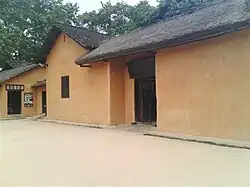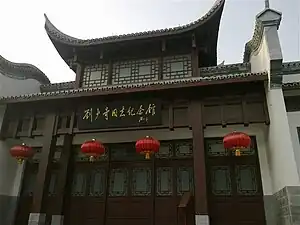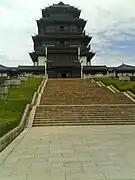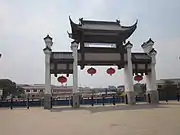Former Residence of Liu Shaoqi
The Former Residence of Liu Shaoqi or Liu Shaoqi's Former Residence (simplified Chinese: 刘少奇故居; traditional Chinese: 劉少奇故居; pinyin: Liú Shàoqí Gùjū) was built in the late Qing Dynasty (1644–1911).[1][2] It is located in Huaminglou Town of Ningxiang, Hunan, China.[1][2][3] It has an area of about 4,000,000-square-metre (43,000,000 sq ft) and a building area of about 20,000-square-metre (220,000 sq ft), embodies buildings such as the old houses, the Liu Shaoqi Memorial Hall, the Bronze Statue of Liu Shaoqi, the Cultural relics Exhibition Hall.[2][4]
| Former Residence of Liu Shaoqi | |
|---|---|
刘少奇故居 | |
 Former Residence of Liu Shaoqi | |
  | |
| General information | |
| Type | Traditional folk houses |
| Location | Huaminglou Town, Ningxiang City, Hunan Province |
| Country | China |
| Coordinates | 28°01′56″N 112°38′44″E |
| Completed | 1796 |
| Opened | 1959 |
| Owner | Government of Ningxiang |
| Technical details | |
| Floor area | 20,000-square-metre (220,000 sq ft) |
| Grounds | 4,000,000-square-metre (43,000,000 sq ft) |
History
In 1796, in the first year of the age of the Jiaqing Emperor, it was built by Liu Shaoqi's forebear.[5]
In 1898, Liu Shaoqi was born here.[1][5]
On its opening late in 1959, it was listed as a "Historical and Cultural Sites Protected at the Provincial Level".[5]
In May 1961, Chinese President Liu Shaoqi and his wife, first lady Wang Guangmei returned to Hunan and they lived here. During the Great Leap Forward, Liu Shaoqi handed out their own daily necessities to farmers.
In 1966, during the Cultural Revolution, the house was broken down by the Red Guards and the cultural relics were stolen.[5] On October 1, 1966, the site was closed.[5]
In February 1980, President Liu Shaoqi was rehabilitated. The People's Government of Hunan Province and the People's Government of Ningxiang rebuilt the house.[5] On March 5, it was opened to the public again.[5]
In 1982, China's leader Deng Xiaoping wrote "Liu Shao-qi's Former Residence" on the horizontal tablet.[6][5]
In January 1988, it was listed as a "Major Historical and Cultural Site Protected at the National Level" by the State Council of China.[1][5]
Gallery
 The Liu Shaoqi Memorial Hall.
The Liu Shaoqi Memorial Hall. The Huaming Tower.
The Huaming Tower. Bronze statue of Liu Shaoqi.
Bronze statue of Liu Shaoqi. Paifang at the Former Residence of Liu Shaoqi.
Paifang at the Former Residence of Liu Shaoqi.
References
- Wang Xijia (2014), p. 16.
- Huang Haichao & Jiang Hongzhao (2002), p. 18.
- "1 Day Red China Tour from Changsha To Shaoshan - Hometown Of Chinaman Mao". discoverchinatours.com. 2015.
- "Huaminglou, Liu Shaoqi's former residence".
- 宁乡县花明楼刘少奇故居和纪念馆. Xinhuanews (in Chinese). 2011. Archived from the original on 2016-11-21.
- Huang Haichao & Jiang Hongzhao (2002), p. 47.
Bibliography
- Wang Xijia (2014). "Cultural Relics" 文化古迹. 长沙史话 [A Brief History of Changsha] (in Chinese). Beijing: Social Sciences Academic Press. ISBN 978-7-5097-6662-0.
- Huang Haichao; Jiang Hongzhao (2002). 宁乡史地 [History and Geography of Ningxiang] (in Chinese). Haikou, Hainan: Nanfang Publishing House. ISBN 7-80660-538-X.